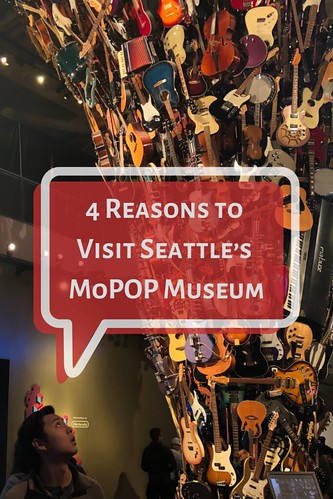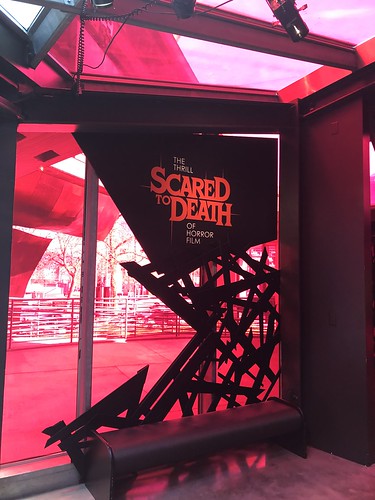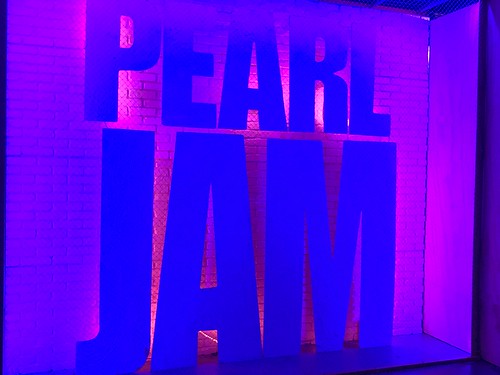Indie video game designers discussing their craft. Hundreds of guitars strung together to form a sort of musical tornado emerging from the floor. High school art from a singer who helped create the grunge movement.
While I expected Seattle’s Museum of Pop Culture, or MoPOP, would offer plenty of culture-defining finds, I was still surprised by the variety and thoughtfulness behind the exhibits.
Yes, the exhibit about Nirvana was a comforting trip down memory lane and the words of “Come as You Are,” immediately started shuffling through my head when I walked through the exhibit doors. But what’s fascinating about MoPOP is how it places, and frames, different elements of pop culture (including Nirvana) into a broader context so visitors have a better understanding of how those elements became influential.
Sure, Pike Place Market and the Space Needle tend to be top draws to the Emerald City for out-of-towners, but I’d recommend carving out some time to visit MoPOP, too. Here’s a few reasons the museum is a standout.

#4 MoPOP’s main focus? Experiencing creativity
The brainchild of former Microsoft co-founder Paul Allen, some of the museum’s guiding principles include what they define as light-bulb moments, “We use pop culture as a catalyst for learning, connecting, and creating.” Excitement, too, is a driving force: “We value the thrill that comes from experiencing creativity.”
You can sense that focus throughout the museum – it draws you to think about the genesis of ideas within pop culture and how they’ve influenced your life and everyday elements all around you. Just one example, the entry hall to the winding staircase down to the exhibit, Scared to Death: The Thrill of Horror Film, was pasted with images of people seemingly reacting to tense moments on film. You were quite literally experiencing those range of emotions, which tapped into your own reactions to horror films (and yes, I went through this exhibit very, very quickly since horror films terrify me).
Built in 2000, the museum has undergone five name changes – at one point it was the Experience Music Project and Science Fiction Museum and Hall of Fame, or EMPSFM, for acronym lovers. Thankfully, the museum was reborn under the MoPOP title in 2016.


#3 The architecture alone is a work of art
Designed by famed architect, Frank Gehry, the 140,000-foot museum captures every shred of sunlight and beams. In the shadow of the Space Needle within Seattle Center, the museum’s structure looks like odd-shaped tables draped in metallic cloth being moved by the wind reveal what’s underneath.
The silver, pulsing magenta and bluish structures blend together with textures that play with your image as you walk by. Even on the outside, the museum helps passersby experience creativity.
And that was by design – MoPOP reveals the colorful exterior “conveys all the energy and fluidity of music. Three-thousand panels, made up of 21 thousand individually cut and shaped stainless steel and painted aluminum shingles, encase the outside of the building.” The effect is meant to tap into the same zeitgeist as pop culture – “their individual finishes respond to different light conditions and appear to change when viewed from different angles, reminding audiences that music and culture is constantly evolving.”

Photo: Joe Mabel, Wikimedia Commons
#2 The music exhibits offer a holistic view of artists
MoPOP offers a regular string of music exhibits, including an upcoming one all about Prince. During a recent visit, Pearl Jam and Nirvana took center stage. At the start of the Nirvana exhibit, I was struck by a quote from the band’s bassist Krist Novoselić at the entryway: “When Nirvana hit it big, it was overwhelming because we were part of the counterculture. Nirvana didn’t go to the mainstream – the mainstream came to Nirvana.”
The exhibit then walked visitors through exactly how this counterculture band became a world-wide phenomenon. I found this painting of particular interest – Nirvana’s legendary lead singer, Kurt Cobain, painted what’s called the “New American Gothic,” (circa 1984) in high school. The work appeared in the exhibit along with his art show entry form. According to the exhibit, “Cobain’s creative expressions became more unconventional as he grew older, exhibiting a darker sense of humor and a keen interest in Americana kitsch and human anatomy, all of which informed the music and lyrics he created in Nirvana.”
Other exhibits followed this same format of uncovering the drive behind the artists and then letting the visitor walk through how it evolved – and how that piece of pop culture still carries influence today.

#1 Your inner nerd will thank you
Simply walking through the museum is a sensory experience – the lights, the design, the music. And then there’s the exhibits dedicated to science fiction. I was reminded how much I enjoyed the movie Galaxy Quest when I happened on the suit worn by the actor who portrayed the 1999 sci-fi film’s villain General Roth’h’ar Sarris. And then there was the jacket worn by Arnold Schwarzenegger in Terminator. I heard more than one person gasp when they encountered memorabilia from their favorite sci-fi film. And yes, non-flash photography is fine, so you can take all the selfies you want commanding a starship or next to a galactic cockroach. It’s that kind of place.
Excited conversations were common, too, between parents and kids explaining favorite scenes from sci-fi movies or tales of beloved characaters.

The MoPOP museum is located in the Belltown area of Seattle. Along with the Space Needle, MoPOP is close to other attractions, including the Chihuly Garden and Glass museum, the Seattle Children’s Museum, and the Pacific Science Center.
Kristen J. Gough is the Global Cuisines and Kids Editor for Wandering Educators
All photos courtesy and copyright Kristen J. Gough, except where noted
